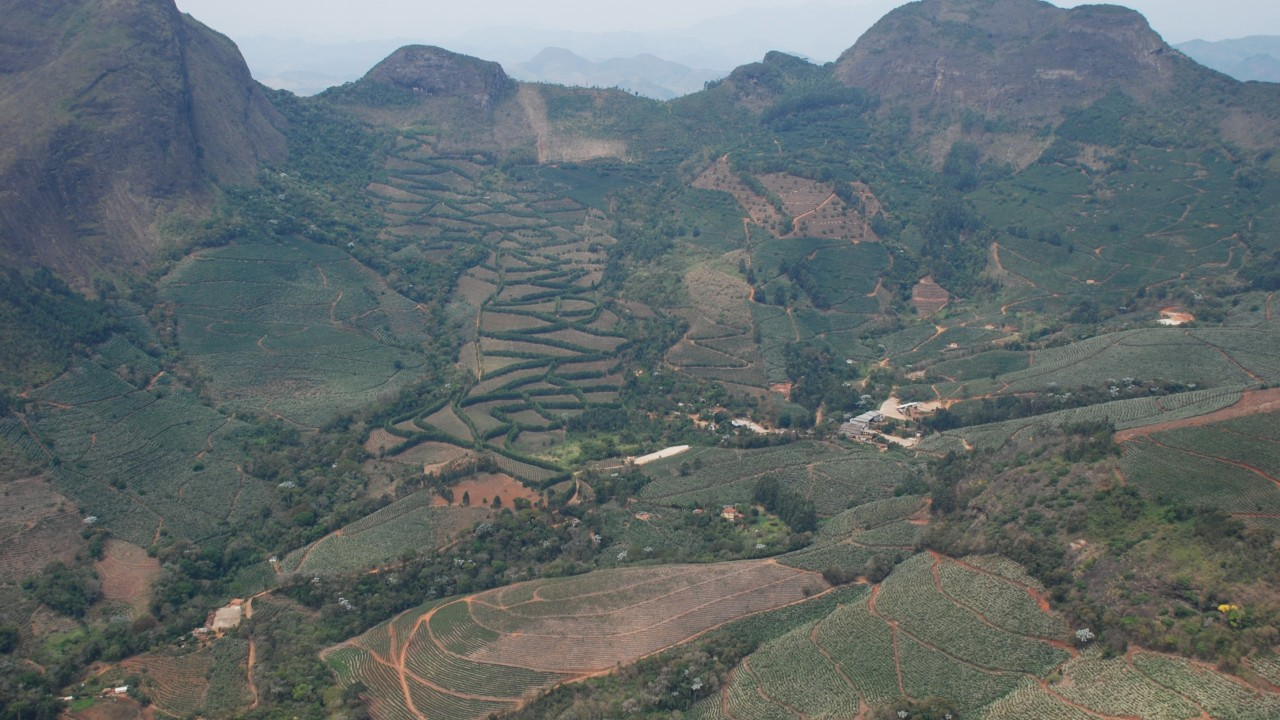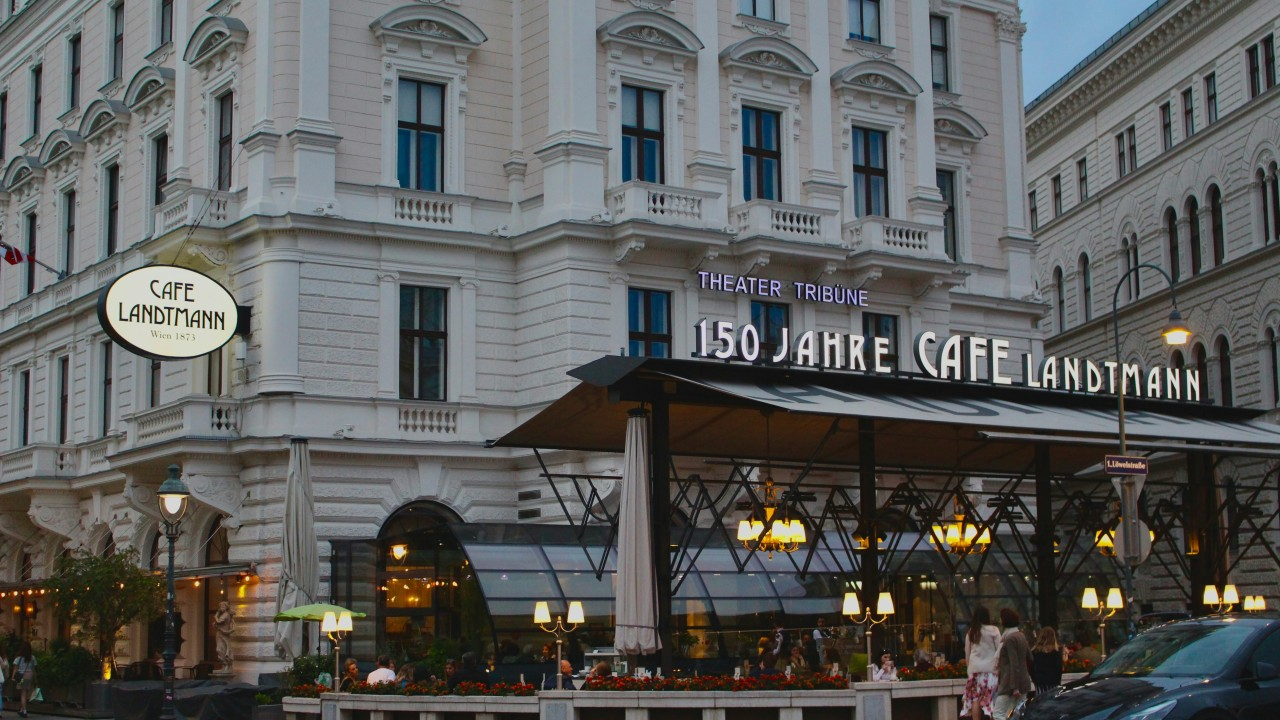Brazil – a superlative in every respect in the coffee market. Since 2016, the country has not only been the world's largest coffee producer for 150 years, with a production of 43,200,000 bags (60 kg each) in 2016, but also the largest consumer market on our planet with 20,300,000 bags (60 kg each) – followed by the USA and then Germany in third place by a wide margin.
Coffee is grown in Brazil on a total area of around 27,000 km2. The largest growing areas are in the states of Minas Gerais, Sao Paulo and Paraná. Brazil has been the world's largest coffee producer since 1840 and reached a world market share of around 80% of coffee production in 1920. Since the 1950s, its global market share has declined due to rising coffee production worldwide.
The first coffee plant was planted in 1727 by Francisco de Melo Palheta in the state of Pará, who smuggled the plants out of French Guiana after negotiating a border dispute there on a diplomatic mission. According to legend, he seduced the governor's wife and received small coffee plants and coffee seeds hidden in a bouquet of flowers as a farewell gift.
Coffee cultivation began in Rio de Janeiro in 1770, but initially only served domestic demand until high demand from America and Europe led to a dramatic increase in production at the beginning of the 19th century. By 1820, Brazil was already producing around 20% of the world's coffee.
Initially, the labour required for coffee production was provided by slavery – 1.5 million slaves were brought to Brazil in the first half of the 19th century alone. It was only with the ban on the importation of slaves in 1850 that plantation owners began to recruit European emigrants in order to maintain production. The domestic slave market, which until then had continued to be supplied from the northern parts of the country, remained in existence until 1888, when slavery was finally abolished in Brazil.
In the 1880s, Minas Gerais developed into Brazil's largest coffee-growing region, with the Zona da Mata in particular playing a leading role, accounting for almost 90% of the country's total production. Railway connections and increasing industrialisation led to population growth in Rio de Janeiro and Sao Paulo. Sao Paulo benefited particularly and grew explosively from 30,000 inhabitants (1850) to 70,000 (1890), reaching 240,000 inhabitants just 10 years later in 1900. Just 30 years later, in 1930, São Paulo had over 1,000,000 inhabitants, replacing Rio de Janeiro as the country's largest city and economic centre.

Due to heavy overproduction and soil depletion, coffee production areas shifted further and further westward, accompanied by deforestation and the abandonment of barren, devastated land.
Today, around 10 million people in rural areas of Brazil make their living from coffee cultivation. According to estimates, there are approximately 220,000 coffee farms covering a cultivation area of around 27,000 km2. The vast majority of farms are less than 10 hectares in size (around 70%), around a quarter of farms cover an area of up to 50 hectares, and only 5% of farms are larger than 50 hectares. Brazil mainly produces Arabica coffee (around 70% of production) and 30% Canephora – the variety grown in Brazil is the ‘Quillou’, which originally comes from Madagascar and is called ‘Conillion’ in Brazil. It is mainly grown in Espirito Santo in the south-east and Rodônia in the north-west.
Probably the most famous Brazilian Arabica is Catuaí, which is available as a red-ripe variety and also as a yellow-ripe variety. It was bred from a cross between the dwarf Bourbon variety Caturra and the majestically tall Mundo Novo (a cross between Bourbon and Tipica). The high yield and the associated high sweetness form the basis for a coffee that produces incomparable flavour profiles, even in espresso roasts. This is reason enough to find Brazilian coffee in large proportions in most espresso roasts.
Brazilians usually process coffee using the ‘natural’ method, i.e. dry processing, which gives Brazilian coffees a high basic sweetness and a lot of body. Brazilian coffees are therefore ideal for espresso roasts and also as a basis for blends to achieve a lot of balance and body.
Another widely used processing method is ‘pulped natural’, in which the coffee beans are squeezed out of the cherries in a pulper and then dried directly – with the remaining mucilage (sugar slime) still attached, which gives the coffee an even higher natural sweetness. This method, which originated in Brazil, is now also used in other countries, but is usually referred to as ‘honey’ processing.
Pulped natural is the umbrella term for all processing methods in which the mucilage remains attached to the parchment coffee. Depending on the amount of sugar mucilage, the parchment coffee turns yellowish, reddish or dark brown and is then often marketed as yellow, red or black honey. All of these processing methods are subcategories of ‘pulped natural’.
In addition to all this green coffee, Brazil has always had a distinctive coffee culture in terms of coffee consumption.
‘Cafezinho’ is the Brazilian coffee. It is available at every opportunity, in every place and in many later variations – for now, at least, because European espresso culture is rapidly sweeping across the national coffee market before any adaptation or further development can take place here. Hopefully, part of this culture will be saved before it is lost, as so many other national coffee traditions have been before it.
Cafezinho, or ‘small coffee’, is prepared with water in which sugar has been dissolved to taste, to which finely ground coffee is added while boiling. The coffee is then removed from the heat and filtered – traditionally using a cotton filter, which gives the coffee significantly more body than when using a paper filter.
Another popular drink is ‘café com leite’, Brazilian milk coffee, which is prepared from a cafezinho or espresso with the addition of hot milk. The milk is usually poured into the coffee in a medium-sized cup in front of the guest until they have enough milk in their drink. Two jugs are also served – one with coffee and one with hot milk – to allow the guest to mix their own ideal milk coffee.
A special type of ‘café com leite’ – sort of like an Austrian melange – is the ‘café pingado’, a latte with more coffee and less milk than usual.
Café curto or café expresso is the Brazilian espresso, a short, strong and bitter coffee prepared in an espresso machine. However, the extraction process has little to do with a correctly prepared espresso.
The ‘Carioca’ or ‘Café carioca’ is comparable to a caffè lungo, but is prepared with more volume in a larger cup.
Brazil has also developed a variety of interesting forms and types of coffee bars and coffee houses, which are definitely worth visiting – in addition to a cafezinho in a simple traditional coffee bar for workers.
Rio de Janeiro
Confeitaria Colombo [www.confeitariacolombo.com.br], the patisserie founded in 1894 at Rua Gonçalves Dias, 32 in Rio de Janeiro, is undoubtedly one of the most famous coffee houses in the world and offers a wide selection of fine baked goods, which are served in the mirrored room at numerous small marble tables.
Confeitaria Cavé [www.confeitariacave.com.br], located at Rua 7 de Setembro, 137, in the city centre, is the oldest coffee house in the city, dating back to 1860. The interior is now quite worn, and the neon signs do not particularly enhance its appeal. However, the selection of baked goods more than makes up for this.
Armazém do Café [www.armazemdocafe.com.br] is a local chain with eight locations in Rio. The first opened in 1997 in Ipanema, at Rua Maria Quitéria, 77. It offers a variety of coffee beans and blends from all of Brazil's coffee-growing regions.
Largo das Letras [www.largodasletras.com.br], located in a city palace at Rua Almirante Alexandrino, 501, is a witness to the history of Santa Teresa. The view is definitely worth seeing.
Café Rubro [www.rubrocafe.com.br] is one of the best places for espresso in Rio. The company now has three shops. The small shop at Rua da Quitanda, 191, in Centro smells of green coffee, which is roasted on site.
São Paulo
Coffee Lab [www.coffeelab.com.br], at Rua Fradique Coutinho, 1340, in the artistic district of Vila Madalena in São Paulo, is one of the best places for good coffee in the metropolis. The shop has its own roastery and offers a variety of preparation styles.
Beluga Café [www.belugasp.com] at Rua Doutor Cesario Mota Junior 379, São Paulo, is one of the hip coffee shops in the city centre.
Santo Grão Café [www.santograo.com.br], now with several locations, is particularly iconic in Jardins, Rua Oscar Freire, 413. In addition to its own roasts of various coffees from different regions of Brazil.
Octavio Café [www.octaviocafe.com.br] at Av. Brg. Faria Lima, 2996, Jardim Paulistano is a coffee house made of wood and glass in the shape of a coffee bean with a unique character. The coffees come from the family's own farms and are offered there in a variety of preparations.
In addition to these tips, there are countless traditional and modern coffee houses and cafés to discover in all cities and locations – the café in the ‘Bolsa do Café’ in Santos, where coffee used to be traded and which now houses a beautiful coffee museum, is also definitely worth a visit. Brazil is definitely worth a visit when it comes to coffee.
#Coffee #Brazil #CoffeeCulture #SpecialtyCoffee #Espresso #Arabica #Cafezinho #LinkedInArticle #CoffeeEnjoyment #CoffeeJourney


Comments (1)
kakembo Amon Noris
August 29, 2025helloohhnnfnkfbdjbjkbfdd
Leave a Comment